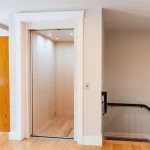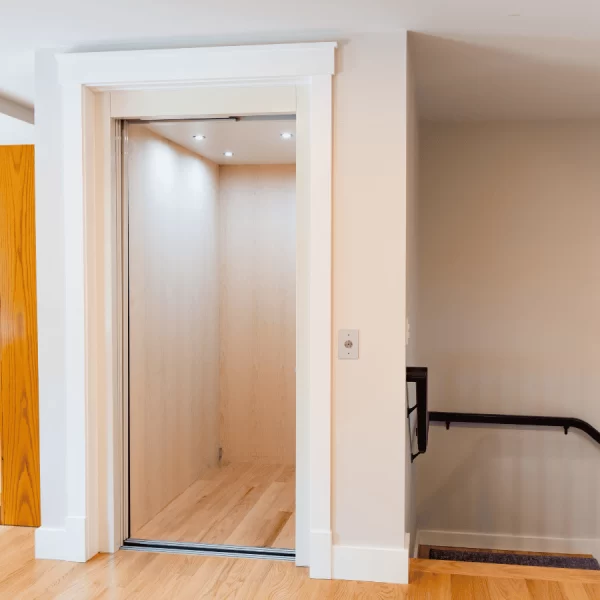
Exploring the Crucial Decision: Replacing Stairs with an Elevator
February 28, 2025
Simple Steps: Choosing the Right Stair Seat Lift for Your Needs
March 10, 2025Innovation in home design means elevating your ideas and your living space. If you’re considering a house elevator, you can create beautifully functional designs that enhance accessibility and style. By integrating a house elevator, you can ensure seamless movement between floors while maintaining aesthetic appeal. In this guide, you’ll discover practical steps and inspiring ideas to elevate your home’s interior, transforming your space into a modern, inviting environment.
Key Takeaways:
- A house elevator can enhance accessibility while seamlessly blending with contemporary interior styles.
- Design options for elevators range from minimalist and sleek to more ornate styles, allowing homeowners to choose an aesthetic that complements their space.
- Practical considerations, such as space planning and technology integration, play a significant role in ensuring the elevator meets both functional and design needs.
Understanding House Elevators
House elevators present an innovative solution for homeowners looking to blend convenience with modern design. These elevators are designed for residential use and provide easy access across multiple floors, which can enhance both functionality and aesthetic appeal in your home.
Types of House Elevators
For those considering a house elevator, it’s essential to understand the different types available:
| Hydraulic Elevators | Utilize a hydraulic system for lifting, offering smooth rides. |
| Machine Room-Less Elevators | Eliminate the need for a separate machine room, saving space. |
| Pneumatic Elevators | Use air pressure to move the elevator, allowing for easier installation. |
| Vertical Platform Lifts | Ideal for wheelchairs, they provide access to various levels. |
| Commercial-Grade Elevators | Designed for heavy usage, suitable for larger homes. |
Knowing the types of house elevators can help you make a more informed decision tailored to your specific needs.
Benefits of Installing a House Elevator
For many homeowners, installing a house elevator goes beyond mere convenience; it elevates your living experience significantly.
A house elevator improves accessibility for all family members, especially the elderly and those with mobility challenges. It also adds to the overall value of your property, making it more appealing to future buyers. Additionally, you can enjoy enhanced safety, as elevators can reduce the risk of falls. Investing in a house elevator can lead to a more luxurious lifestyle, offering you the comfort and ease you deserve.
How to Design with a House Elevator
When incorporating a house elevator into your modern design, it’s crucial to integrate it seamlessly with the overall architecture. Consider the flow of your space and how the elevator’s presence can enhance accessibility without compromising aesthetics. Ensure the elevator is not merely an afterthought but a vital component that complements your home’s style.
Planning the Space
When planning the space for your house elevator, you must assess the layout and identify the best location for optimal access and functionality. Think about how the elevator will interact with the surrounding areas, such as hallways and rooms, ensuring you allow enough clearance and choose appropriate doorways for smooth operation.
Choosing the Right Style
An essential aspect of integrating an elevator is selecting a style that matches the overall interior design of your home. This means considering the elevator car and the cabinets, materials, and finishes. Each choice reflects your taste and can enhance or detract from your home’s visual appeal.
Choosing the right style for your house elevator goes beyond aesthetics; it should also align with your functional needs and your home’s overall ambiance. For contemporary designs, sleek, minimalist elevators with glass panels can create a stunning focal point. Alternatively, wooden finishes with intricate details can seamlessly blend with the elevator for traditional settings. Ensure choices, such as flooring and lighting, complement the overall design while emphasizing your style and enhancing the value of your property.
Tips for Incorporating a House Elevator into Modern Design
Not only does adding a house elevator increase the value of your property, but it also enhances its functionality. Here are some tips to seamlessly integrate a house elevator into your modern design:
- Choose a sleek, contemporary design for the elevator.
- Position the elevator in an area that minimizes spatial disruption.
- Incorporate materials and finishes that match your overall aesthetic.
- Utilize innovative technology for added convenience.
Thou will elevate your home’s design with these thoughtful integrations.
Integrating with Interior Aesthetics
Aesthetics play a pivotal role in how your house elevator complements your space. You should consider a design that mirrors the lines and colors of your existing interior, utilizing glass panels for a modern look and natural woodwork for warmth. Creating a cohesive vibe with your elevator enhances its visual appeal and functionality, making it a seamlessly integrated element of your home.
Enhancing Accessibility and Functionality
A house elevator enhances accessibility for everyone in your home, making it easier for individuals with mobility challenges to navigate different levels. You can prioritize convenience by ensuring your elevator is located centrally, allowing easy access from key areas. Furthermore, consider installing a lift that accommodates heavy items, enhancing your functionality and allowing you to effortlessly transport groceries, furniture, or other large objects.
A house elevator promotes safety and fosters independence for family members or guests with diverse needs. By incorporating features like voice activation or remote controls, you enhance usability, allowing you to ensure that everyone can access the upper levels of your home without physical strain. The payoff of well-planned functionality is invaluable; it transforms your living space while improving your quality of life.
Factors to Consider Before Installation
All homeowners should evaluate several factors before choosing to install a house elevator. Consider your home’s space, aesthetic preferences, and infrastructure to support this addition. Key points to think about include:
- Space Requirements
- Design Compatibility
- Accessibility Needs
- Maintenance and Service
After assessing these factors, you can ensure the best fit for your modern living environment.
Budget and Cost Analysis
Before proceeding with your house elevator installation, you must conduct a thorough budget and cost analysis. Evaluate not just the initial installation costs, but also ongoing maintenance and potential renovations required for integration.
Building Codes and Regulations
Building codes and regulations are pivotal in successfully installing your house elevator. You should familiarize yourself with local codes, as they ensure compliance and safety in your home renovation. Many jurisdictions require that elevators meet specific safety standards, conduct regular inspections, and obtain necessary permits. Additionally, you should consult a professional to navigate any zoning laws that may affect your project. Adhering to these requirements can prevent costly delays or safety issues, ensuring the elevator serves its purpose without compromising safety.
The legal framework is designed to protect you and your home, but ignoring these regulations can lead to severe consequences. Always seek professional guidance to ensure your house elevator installation meets all applicable laws, safeguarding your investment and peace of mind.
How to Maintain Your House Elevator
Unlike many home features, maintaining your house elevator ensures longevity and safety. Regular upkeep protects against potential issues and can enhance performance over time. Investing in consistent maintenance ensures that your elevator operates smoothly, safeguarding your property and loved ones.
Regular Maintenance Tips
Incorporating simple practices can significantly enhance your house elevator‘s efficiency. Follow these tips for effective maintenance:
- Perform routine inspections of all components.
- Check for any wear and tear on cables and rails.
- Clean the elevator regularly to avoid dirt accumulation.
- Schedule professional maintenance every 6-12 months.
You will find these practices beneficial for prolonging the life of your elevator.
Troubleshooting Common Issues
Understanding common issues faced with your house elevator can simplify troubleshooting. Be proactive in identifying any irregularities, such as strange noises or erratic movements.
It is essential to act swiftly if you encounter issues like a stalled elevator or malfunctioning controls. Regularly check for signs of electrical malfunction and ensure that safety features are fully operational. If the elevator doesn’t respond or the doors fail to open, you should inspect the power supply and circuitry. If problems persist, consult a professional technician immediately. Addressing these concerns promptly can lead to a safer and more efficient elevator experience.
Innovative Features to Explore
Explore the exciting options when integrating a house elevator into your modern design. Elevators are no longer just functional; they can also serve as stunning architectural features. With options like panoramic glass elevators that offer breathtaking views or stylishly designed cabin interiors, you can enhance both aesthetics and usability in your home.
Smart Technology Integration
For a seamless living experience, consider incorporating innovative technology into your house elevator system. Features such as smartphone controls, voice commands, and integration with home automation systems enhance your convenience and accessibility. Furthermore, remote monitoring capabilities allow you to track the elevator’s performance and status, ensuring a reliable and efficient operation.
Energy Efficiency Considerations
Integrating energy-efficient technologies in your house elevator can significantly impact overall energy consumption. Opting for elevators that use regenerative drives and LED lighting can lead to lower electricity bills while being environmentally friendly. Moreover, some models are designed to consume less energy during operation, making them a smart choice for the long-term sustainability of your home.
Understanding the innovative energy-efficient options available for your house elevator can lead to substantial savings and a lighter environmental footprint. These systems often utilize regenerative braking technology that recaptures energy during operation, converting it into usable power. Additionally, choosing elevators with energy-efficient motors and smart controls can minimize energy usage when not in active use. By prioritizing energy efficiency, you protect the planet while maximizing the functionality and sustainability of your home.
To wrap up
Taking this into account, incorporating a house elevator into your modern design can enhance both style and functionality. You can create a seamless integration that elevates your living experience by thoughtfully considering placement, aesthetics, and technology. Whether for accessibility or convenience, an elevator can reflect your taste while adding significant value to your home. Embrace this innovative solution to elevate not just your home, but also your day-to-day life.
FAQ
Q: How does incorporating a house elevator enhance modern home design?
A: Incorporating a house elevator into modern home design can enhance functionality and aesthetics significantly. Elevators offer convenient vertical transportation, making multi-story homes accessible for everyone, including older people and those with mobility challenges. Moreover, with innovative designs, these elevators can blend seamlessly with the home’s architecture, serving as stylish focal points. They can be customized in various finishes, materials, and sizes to complement the overall design theme, adding a touch of luxury while maintaining a streamlined look.
Q: What are some design considerations when planning for a house elevator?
A: Several design considerations should be considered when planning for a house elevator. First, analyze the available space; elevators require specific dimensions for installation and operation. It’s also important to consider the placement—elevators can be designed to fit into existing stairwells or function as standalone features. Additionally, aesthetic choices, such as the type of materials and finishes, should align with the overall home design to create a cohesive appearance. Lastly, consult an architect or designer to ensure structural integrity and that building codes are met during installation.
Q: Do homeowners know of any maintenance requirements for residential elevators?
A: Yes, homeowners should know specific maintenance requirements for residential elevators to ensure their safety and functionality. Regular inspections are typically recommended yearly to assess the elevator’s mechanical components and safety features. Homeowners should also monitor the elevator’s performance, noting any unusual sounds or operational issues. Routine cleaning of the elevator shaft and cabin, and promptly addressing any minor repairs, will help prolong the elevator’s lifespan. Engaging a professional service for maintenance can provide peace of mind and ensure compliance with safety standards.

Introducing Jeff Cates, the visionary Founder and Owner of CAPS Remodeling. After experiencing a profound personal event involving his son in 2007, Jeff was inspired to serve a higher purpose: to create safer, more comfortable, and independent living conditions for the elderly and disabled by modifying their current homes. Jeff’s deep-seated religious beliefs form the moral compass that steers CAPS daily operations. Apart from his unwavering dedication to his work, Jeff finds joy in boating and cherishing moments with his family.



